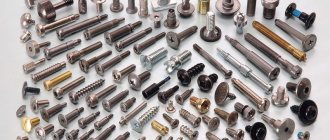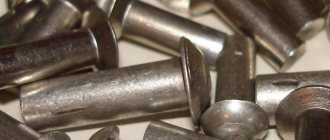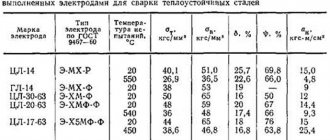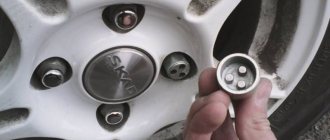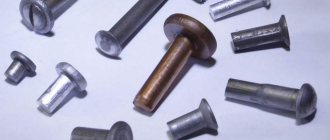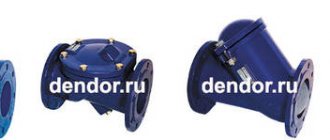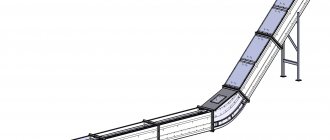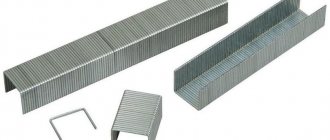Application
In principle, rivets with a threaded element can be used to create almost any connection.
However, they are most relevant in cases where, after assembly, there will be no full access to the reverse side of the articulated parts of the structure. They, like other types of rivets, are most often used when connecting elements made of sheet materials. Such hardware products are characterized by maximum ease of installation, which does not require a large arsenal of special equipment. Very often it will be much easier to install such a rivet than to cut a thread or use welding
It is also important to consider that some models provide the possibility of an additional, most durable connection using bolts or screws of the appropriate diameter. The scope of application of the described devices is determined, first of all, by their type and material of manufacture
Thus, the installation of nut rivets is advisable in limited space. At the same time, the use of hexagonal models will help prevent the risk of rotation during installation. In addition, manufacturers offer rivets for assembling structures designed for specific operating conditions.
Taking into account the installation principle, threaded rivets can be called largely identical to their pull-out counterparts. At the same time, the algorithm of actions during the execution of work includes several main stages. We are talking about preparing the surfaces to be joined, drilling holes of the appropriate diameter and directly installing the fasteners
It is important to remember that the quality of the seam formed is determined, among other things, by the row. Taking into account the requirements, a multi-row scheme with a chain or staggered arrangement of elements can be used
To simplify the assembly process as much as possible and reduce time costs, special devices are used - riveters. This tool can be equipped with a manual, pneumatic, or hydraulic drive.
When analyzing the possibility of using threaded rivets, it should be taken into account that the durability of such connections is determined by the outer diameter of the installed hardware products. And in this case we are talking about a directly proportional dependence. In other words, the larger the size of the rivet, the stronger the seam and the higher its resistance to various loads. In addition, the list of factors affecting the quality of connections in a given situation includes the lack of corrugation and wall thickness. However, these characteristics simultaneously affect the convenience of performing all the work provided for by the technology.
About threaded rivets, see the video below.
Other types of rivets
In addition to threaded rivets, there are blind and standard types of rivets. Previously, the standard rivet version was more used. It is a cylinder, one of which has an extension. The latter is made in a semicircular shape or with a hidden part. Installing such a rivet requires more effort than with other types. Such clamps are practically out of use. The first step for installation is to fix the two parts in the position in which they will be fixed. Clamps are used for these purposes. After this, the location where the drilling will be done is marked. The diameter of the hole should be 10% larger than the diameter of the rivet itself.
After this, a rivet is inserted into the prepared hole; it must be placed on the reverse side so that the part without the head is directed upward. After this, the parts must be positioned in such a way that there is a good stop for the rivet head. After this, the straight section is riveted, as shown in the photo. To do this, you can use a hammer or a special electric tool. The protruding part of the rivet must be given the same shape as its head. Riveting must be carried out in such a way that the body of the rivet completely fills the hole in the parts. If this does not happen, then under the cutting force the rivet will fail and the assembly will be destroyed. The length of the rivet should not be too long or too short. In some cases, for greater ductility, a regular rivet can be heated with a gas burner.
The type of exhaust fastener is shown in the illustration above. Installing such an element is several times easier, since the entire process is automated. Each fastener has a steel or other rod, which performs the task. The rod is connected to a small ball, which is located at the end of the element. Selecting the diameter and drilling the hole is carried out as in the above option. After this, the latch is installed in its place. The riveter is installed in such a way that the core is fixed in its chuck. As the handles are squeezed, the rod pulls up the ball, which flattens the back side of the fastener and thus fixes the two parts. The rod is cut automatically as soon as the force reaches the limit value.
Product advantages
Essentially, threaded rivets are hybrids of traditional nuts. But they should not be confused with exhaust vents. They have advantages, including:
- ease of installation work;
- you can reliably connect components made from fragile materials or those that have insignificant thickness (rolled sheet metal), because the rivet nut will not lead to deformation;
- if the total thickness of the products exceeds the length of the fasteners, then a one-sided fixation is made, without a through passage, and the quality of work will not be low.
Types of threaded rivets
The range is quite wide, there are many classifications of fasteners. So, they can have a flat or countersunk head, a nut or screw thread, a round or hexagonal leg (does not allow rotation in the mounting sockets)
If you take into account the purpose, then there may be:
- electrically conductive;
- having increased force (possibly indentation or stretching);
- for highly hermetic connections;
- with enlarged heads;
- with inch thread application;
- with special marks (for visual identification);
- with vibration isolation.
Materials used for production
The fasteners in question may have different sides. To get regular connections, buy nuts that have standard flanges. If you need to get a slight gap between the parts, it is better to use hardware with reduced or hidden sides. It is worth considering that before installation begins, the procedure of countersinking the holes into which the rivets will be placed is performed.
Threaded rivet nuts can be produced from several types of metal, in particular:
- Carbon steel. For the production of universal products and the creation of standard connections.
- Made of stainless steel. Production of hardware that will be used at high temperatures or in places with high humidity levels.
- Made of aluminum. Such rivets are distinguished by their low weight and excellent anti-corrosion properties.
- Made of bronze. This metal is used if fasteners with low spark generation rates are needed.
Peculiarities
Initially, it is worth recalling that until relatively recently, rivets were one of the most common types of hardware products. Today, despite the active introduction of advanced technologies and innovative technical solutions, the relevance of such fasteners remains in many modern areas. The design features and operating principle of threaded rivets deserve special attention.
It is important to consider that regardless of the variety, they work the same
At their core, all rivets are fasteners in the form of a sleeve with a folding head. On the other hand, there is a head that closes during the assembly process. If we compare the more familiar exhaust systems and the fastening devices under consideration, it will become clear that the latter differ, first of all, in the presence of a threaded element. In this case we are talking about a compact structure in the form of a sleeve (rod) having a cylindrical or hexagonal shape. Its upper part is equipped with a support side, and the lower part has a thread.
When considering the features of threaded rivets, it is necessary to pay special attention to the following clear advantages of this type of fastening devices
- Maximum ease of use.
- The strength of the connections created, including, if necessary, the installation of structures from fragile elements. This refers, for example, to thin sheet iron, even slight deformation of which during the assembly process is unacceptable.
- Possibility of high-quality unilateral fixation. This point is most relevant in situations where the total thickness of the parts being fastened exceeds the length of the hardware product. In this case, threaded rivets are able to ensure reliable installation without loss of performance characteristics of the structure.
- Maintaining fastening strength for a long time.
- Complete absence of chemical and mechanical aggressiveness.
- Preservation of the paint coating of the surfaces of the parts to be joined.
- Possibility of durable connection of structural elements made of different materials.
- Absence of any stresses of a mechanical nature.
- Possibility of repeated dismantling with re-installation of fasteners.
At the moment, preference is increasingly being given to welds, soldering or gluing. However, despite all the undeniable advantages of this type of connection, in some situations the only rational solution is the use of rivets with a threaded element. In addition to all of the above, it should be noted that such devices can withstand significant thermal loads.
Also, threaded rivets do not cause structural changes in the mounted parts, which cannot be said about welding. This point is very important when joining different materials. And do not forget that the described hardware products, if necessary, ensure the preservation of the mobility of structural elements.
Naturally, there are certain disadvantages of such rivets, which include the following important points.
- At the preparatory stage, it is necessary to carry out the most accurate markings and make holes of the appropriate diameters.
- In the vast majority of cases, there is no tightness of the seams created. In some situations, the solution may be to install rubber gaskets or gaskets made of other materials.
- The work is accompanied by quite noticeable noise.
Materials
Above we have already focused on the variety of materials used in the production of the described hardware. However, it is worth describing in more detail the most common versions of threaded rivets
And in this case we are talking about the following important points.
- For universal fasteners and when creating standard connections, carbon steel is usually used.
- The choice in favor of “stainless steel” is justified in situations where it is necessary to create joints of structural elements operating at high temperatures and in conditions of high humidity.
- The main differences of aluminum rivets include, first of all, outstanding anti-corrosion properties and minimal weight.
- Bronze will be the optimal solution if you need to use fasteners made of materials with minimal spark formation.
In addition to everything already listed, it is worth noting that in some cases neoprene is used as a raw material. Products made from this polymer are self-aligning. In such cases, there is no need to use special tools and equipment.
Installing threaded rivets without a rivet gun
It is not always possible to have an expensive professional tool at your disposal. In addition, if it is necessary to perform one-time operations, its purchase is impractical. In such cases, work is performed without the use of special tools. There are several ways to rivet a threaded rivet without a riveter. The easiest way to install threaded rivets without a rivet gun is to use a screwdriver. For this purpose, a special nozzle is used, the body of which houses a bolt with a collapsible thrust bearing. The bolt, through a notched end nut, is screwed into the rivet, which is then installed in the mounting hole. After this, the screwdriver is turned on and, due to the rotation of the bolt, a force is created that forms the collar and fixes the rivet. A knurled nut and a thrust bearing prevent the rivet from turning. After installation, all that remains is to unscrew the bolt from the fastener, turning the screwdriver into reverse rotation mode. This method makes it possible to use a regular screwdriver as an electric riveter. In the absence of a special attachment, such a structure can be assembled manually.
In general, the listed methods make it possible to perform the installation of threaded rivets quite efficiently without a riveter. The speed and complexity of installation depends on whether a power tool is used.
Overview of species
At the moment, in the corresponding segment of the modern hardware market there is a wide range of fastening devices under consideration. We produce rivet bolts, versions with cylindrical sides, blind and other threaded rivets. On the one hand, this allows you to select the most suitable rivets in each specific case, taking into account all current criteria. At the same time, such diversity causes certain difficulties in choosing.
First of all, we are talking about the material from which the rivets are made, the latter can be:
- steel;
- made from stainless steel;
- copper;
- made of aluminum alloy.
By type of thread
In this case we are not talking about devices with external threads. There are two options for designing rivets with internal threads.
- Nuts with threads from M4 to M8, designed for permanent connection. It is more advisable to install when there is no access to the back side of the parts.
- Screws with threads from M3 to M16, with the help of which a collapsible connection is created.
By head type
In addition to the material of manufacture and thread features, the described fastening devices are divided into types, taking into account the features of the head. There are two categories of models.
- With flat heads - used on small surfaces.
- With countersunk heads - installed when it is necessary to create minimally noticeable connections.
According to the profile of the leg
Taking into account this parameter, all commercially available fastening devices can be divided into the following three types.
- Smooth, which are recommended for use when it is necessary to connect structural elements made of soft and brittle materials.
- Corrugated - threaded rivets, designed to perform installation work related to fastening harder materials. This surface treatment allows you to minimize the possibility of turning the leg.
- Hexagonal - another category of products designed for durable materials. The profile in this case almost completely eliminates the possibility of turning the rivet during its installation and fixation.
By type of pile
Taking into account the features of this part of the hardware, it should be noted that there are rivets with the following types of collars
- Cylindrical.
- Secret.
- Reduced.
The choice in favor of models with a hidden or reduced collar is made if it is necessary to minimize the gap between the parts being connected. It is also necessary to remember several important points in the context of preparing parts and the nuances of performing installation work. In accordance with current rules and regulations, before installing any types of rivets, the mounting holes are always countersinked.
By purpose
Now on the market you can find almost any threaded rivets, including models for plastic, as well as those designed for use when installing a rivet gun. Taking into account the purpose, the following types of models can be distinguished:
- with increased electrical conductivity;
- with a force that allows for stretching or indentation;
- designed to create the most airtight connections;
- having heads of enlarged sizes;
- with inch thread;
- having special marks on the surface designed for quick visual identification;
- with high-quality and effective vibration isolation.
Threaded rivets (nuts)
Threaded rivets are fasteners used for joining sheet materials, as well as creating threaded fastening points on elements where threads cannot be cut. Products differ in the shape of the outer surface, which can be smooth, corrugated, hexagonal, half-hexagonal, they are made with a through hole or blind. There is no specific DIN or GOST standard for this type of fastening elements, so they are also called rivet nuts or riveted nuts.
Depending on the design solutions, threaded rivets are divided into the following types:
- Cylindrical. The products are made in the form of a cylinder with an internal thread for installing fasteners; they may have notches on the outer surface, facilitating more reliable fixation and preventing twisting. They are produced with a hidden or cylindrical side. To make the riveting units more invisible, there is a line of products with a reduced edge.
- Half-hexagonal. The fastener has the form of a cylinder with a hexagon-shaped base. Used for subsequent screwing in of a bolt, screw or stud. Allows you to create reliable fastening points on thin sheet materials.
- Hexagonal. Products are made in a hexagonal shape with a reduced or standard side. Fasteners with a reduced edge are used in fastening units where the surface of the structure after assembly must remain as flat and smooth as possible.
- Blind rivet nuts. Fasteners are cylindrical or hexagonal in shape and have a closed end. Their main purpose is to protect against leakage of oil and other liquids.
Advantages of rivet nuts:
- high resistance to oxidation;
- maintaining the integrity of paint coatings of connected elements;
- no deformation when exposed to temperature;
- formation of threaded connections on thin sheet materials;
- a large selection of designs allows you to select a product for a specific project;
- simplicity of design;
- quick installation, reliability;
- carrying out installation under conditions of approaching the fastening unit from one side;
- no deformation of the material surface when installing fasteners;
- possibility of dismantling if necessary.
Nut rivets are used to solve the following problems:
- carrying out construction work;
- fastening elements with one-way access for installation;
- installation of window frames, ventilation systems;
- furniture assembly, air conditioning installation;
- fastening of thin sheet steel materials;
- joining materials of different thicknesses;
- fastening of lighting systems;
- in the chemical and railway industries;
- formation of threaded connections.
When selecting threaded rivets, take into account the following characteristics:
- The diameter of the hole for the rivet must fully correspond to the diameter of the rivet, otherwise the product will not be fixed in the supporting material.
- The surface for riveting must be perfectly flat; such fasteners should not be installed on wavy materials.
- The length of the rivet must be sufficient to connect two or more materials or to screw in fasteners to secure elements or equipment.
- The diameter of the fastener is selected to match the thread of the bolt, screw or stud that will hold the installed structure or element.
- To carry out installation, you will need a riveter with a special threaded attachment.
- It is preferable to select rivet nuts and fasteners screwed onto their threads from the same material in order to avoid corrosion and ensure high performance characteristics of the formed connections.
Installation of threaded rivets is carried out as follows: the fastener is screwed onto the threaded attachment of the installation tool and placed on a pre-prepared hole in the sheet material. Then the tool mechanism is activated, and upon completion of installation, the rod is unscrewed from the rivet. Installation of fasteners is carried out using manual, battery-powered, and pneumatic riveting tools.
implements wholesale supplies of fastening, anchoring, and rigging construction products. We know what high-quality fasteners are and what role they play in installation and construction work, as well as in solving household and industrial problems. Therefore, we offer you high-quality construction products directly from manufacturers at favorable wholesale prices.
We present to your attention threaded (nut) rivets of various sizes and shapes. Products are of high quality, resistant to corrosion, withstand good loads, and are easy to operate and install. Our company's managers will help you choose the right size rivet to solve a specific problem, taking into account your wishes. We will select not only rivets, but also tools for their installation, allowing riveting to be carried out quickly and efficiently. We will complete your order according to the selected specification and ensure its delivery on time, without delays.
Contact us! We work for you!
Phone, email
